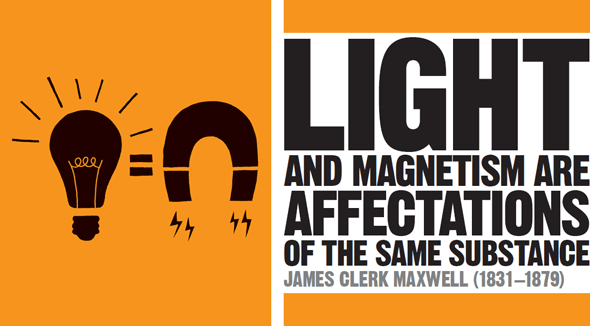
IN CONTEXT
Physics
1803 Thomas Young’s double-slit experiments appear to show that light is a wave.
1820 Hans Christian Ørsted demonstrates a link between electricity and magnetism.
1831 Michael Faraday shows that a changing magnetic field produces an electric field.
1900 Max Planck suggests that in some circumstances, light can be treated as if it were composed of tiny “wave packets”, or quanta.
1905 Albert Einstein shows that light quanta, today known as photons, are real.
1940s Richard Feynman and others develop quantum electrodynamics (QED) to explain the behaviour of light.
The series of differential equations describing the behaviour of electromagnetic fields developed by Scottish physicist James Clerk Maxwell through the 1860s and 1870s are rightly considered one of the towering achievements in the history of physics. A truly transformative discovery, they not only revolutionized the way that scientists viewed electricity, magnetism, and light, but also laid the ground rules for an entirely new style of mathematical physics. This would have far-reaching consequences in the 20th century, and today offers hope for unifying our understanding of the Universe into a comprehensive “Theory of Everything”.
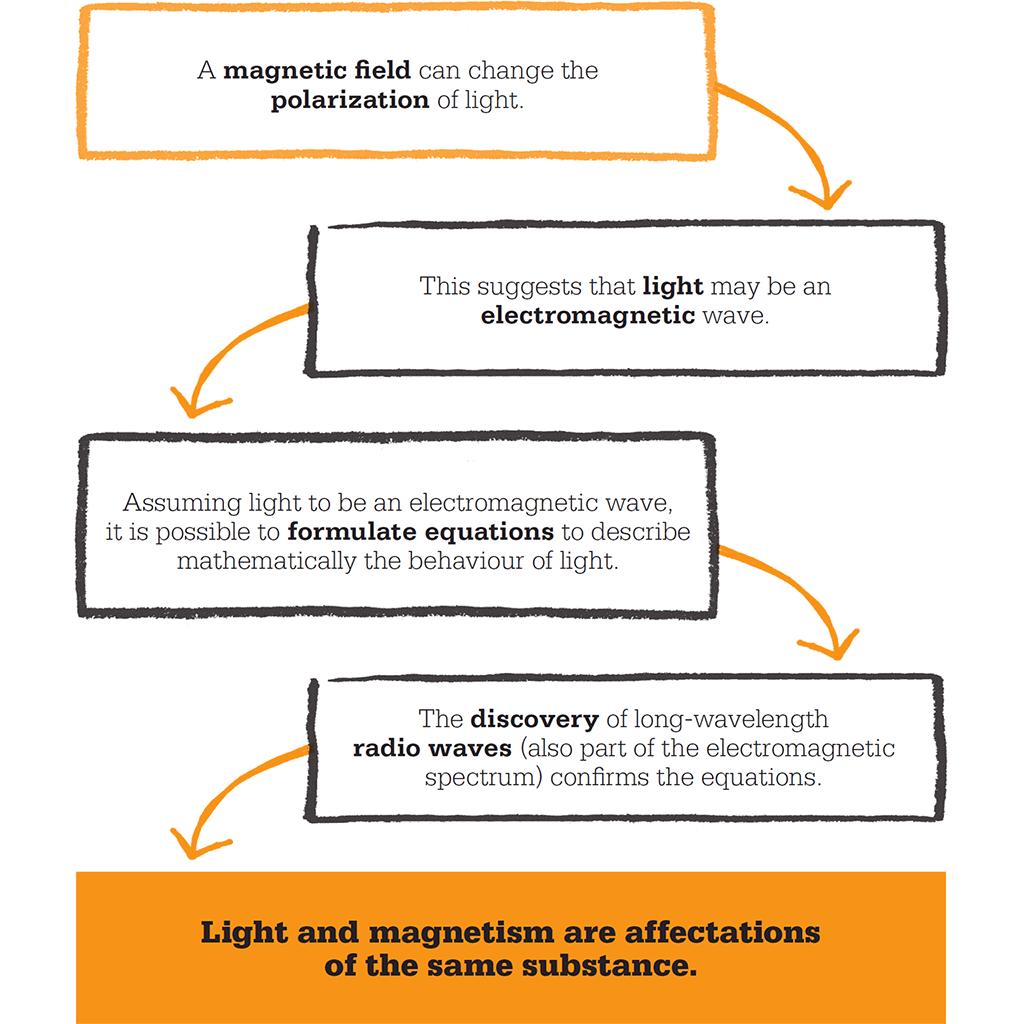
The Faraday effect
Danish physicist Hans Christian Ørsted’s discovery, in 1820, of a link between electricity and magnetism set the stage for a century of attempts to discover the links and interconnections between seemingly unconnected phenomena. It also inspired a significant breakthrough by Michael Faraday. Today, Faraday is perhaps best known for his invention of the electric motor and the discovery of electromagnetic induction, but it was a less celebrated discovery that provided Maxwell’s departure point.
For two decades, Faraday had been attempting, on and off, to find a link between light and electromagnetism. Then, in 1845, he devised an ingenious experiment that answered the question once and for all. It involved passing a beam of polarized light (one in which the waves oscillate in a single direction, easily created by bouncing a beam of light off a smooth reflecting surface) through a strong magnetic field, and testing the angle of polarization on the other side using a special eyepiece. He found that by rotating the orientation of the magnetic field, he was able to affect the angle of polarization of the light. Based on this discovery, Faraday argued for the first time that light waves were some kind of undulation in the lines of force by which he interpreted electromagnetic phenomena.
"The special theory of relativity owes its origins to Maxwell’s equations of the electromagnetic field."
Albert Einstein
Theories of electromagnetism
However, while Faraday was a brilliant experimentalist, it took the genius of Maxwell to put this intuitive idea onto a sound theoretical footing. Maxwell came to the problem from the opposite direction, discovering the link between electricity, magnetism, and light almost by accident.
Maxwell’s main concern was to explain just how the electromagnetic forces involved in phenomena such as Faraday’s induction – where a moving magnet induces an electric current – were operating. Faraday had invented the ingenious idea of “lines of force”, spreading in concentric rings around moving electric currents, or emerging and re-entering the poles of magnets. When electrical conductors moved in relation to these lines, currents flowed within them. The density of the lines of force and the speed of relative motion both influenced the strength of the current.
But while lines of force were a useful aid to understanding the phenomenon, they did not have a physical existence – electrical and magnetic fields make their presence felt at every point in space that lies within their range of influence, not just when certain lines are cut. Scientists who attempted to describe the physics of electromagnetism tended to fall into one of two schools: those who saw electromagnetism as some form of “action at a distance” similar to Newton’s model of gravity, and those who believed that electromagnetism was propagated through space by waves. In general, the supporters of “action at a distance” hailed from continental Europe and followed the theories of electrical pioneer André-Marie Ampère, while the believers in waves tended to be British. One clear way of distinguishing between the two basic theories was that action at a distance would take place instantaneously, while waves would inevitably take some time to propagate through space.
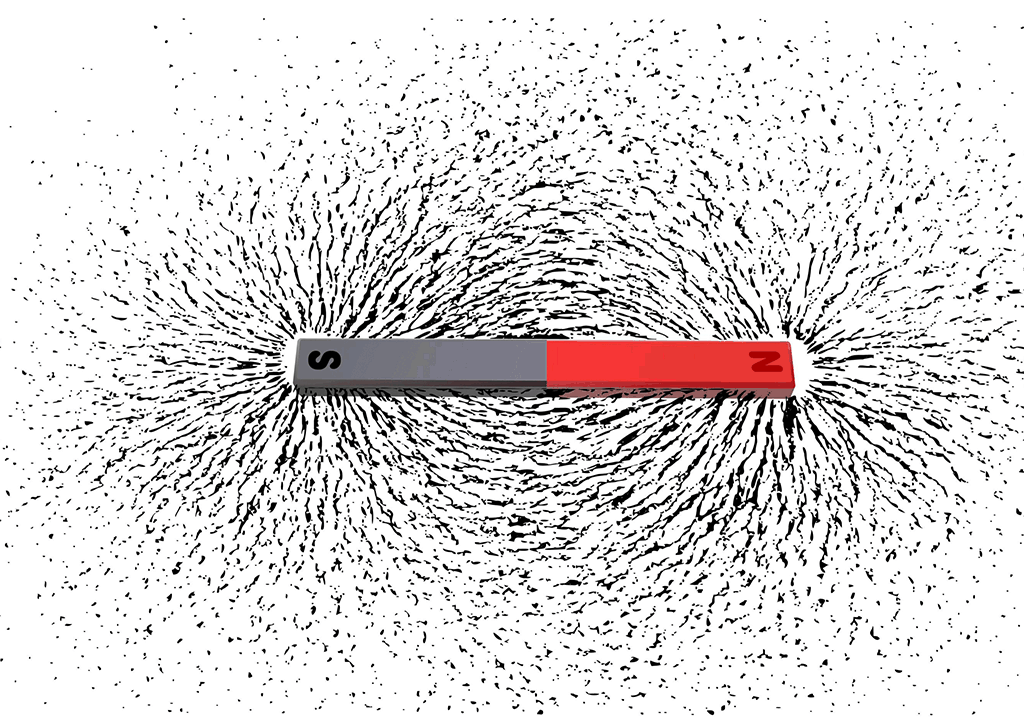
The pattern of iron filings around a magnet would seem to suggest the lines of force described by Faraday. In fact they show the direction of the force experienced by a charge at a given point in an electromagentic field, as represented in Maxwell's equations.
Maxwell’s models
Maxwell began to develop his theory of electromagnetism in a pair of papers published in 1855 and 1856. These were an attempt to model Faraday’s lines of force geometrically in terms of the flow in a (hypothetical) incompressible fluid. He had limited success and in subsequent papers tried an alternative approach, modelling the field as a series of particles and rotating vortices. By analogy, Maxwell was able to demonstrate Ampère’s circuital law, which relates the electric current passing through a conducting loop to the magnetic field around it. Maxwell also showed that in this model, changes in the electromagnetic field would propagate at a finite (if high) speed.
Maxwell derived an approximate value for the speed of propagation, at about 310,700km/s (193,060 miles/s). This value was so suspiciously close to the speed of light as measured in numerous experiments that he immediately realized that Faraday’s intuition about the nature of light must be correct. In the final paper of the series, Maxwell described how magnetism could affect the orientation of an electromagnetic wave as seen in the Faraday effect.
"From a long view of the history of mankind…there can be little doubt that the most significant event of the 19th century will be judged as Maxwell’s discovery of the laws of electrodynamics."
Richard Feynman
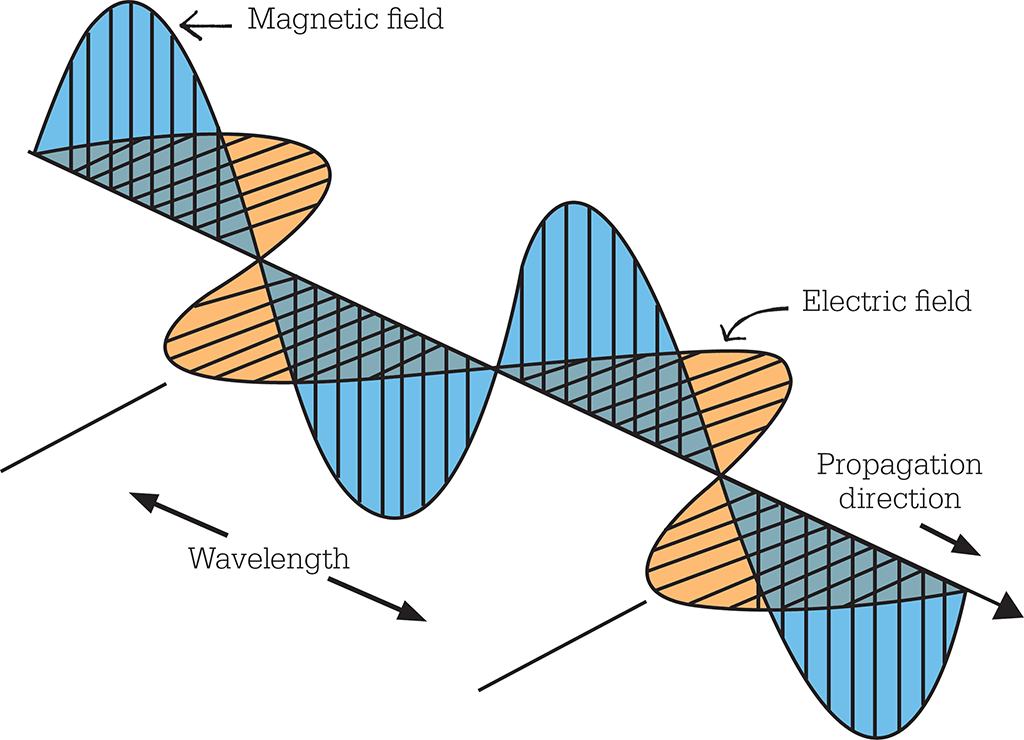
The electrical and magnetic components of an electromagnetic wave move through space while oscillating at right angles to each other and in phase, so that both elements reach their maximum amplitudes at the same time, and constantly reinforce each other by induction.
Developing the equations
Satisfied that the essentials of his theory were correct, Maxwell set out in 1864 to put it on a sound mathematical footing. In A Dynamical Theory of the Electromagnetic Field, he described light as a pair of electrical and magnetic transverse waves, oriented perpendicular to each other and locked in phase in such a way that changes to the electric field reinforce the magnetic field, and vice versa (the orientation of the electrical wave is the one that normally determines the wave’s overall polarization). In the last part of his paper, he laid out a series of 20 equations that offered a complete mathematical description of electromagnetic phenomena in terms of electrical and magnetic potentials – in other words, the amount of electrical or magnetic potential energy a point charge would experience at a specific point in the electromagnetic field.
Maxwell went on to show how electromagnetic waves moving at the speed of light arose naturally from the equations, apparently settling the debate about the nature of electromagnetism once and for all.
He summed up his work on the subject in the 1873 Treatise on Electricity and Magnetism, but, convincing though the theory was, it remained unproven at the time of Maxwell’s death, since the short wavelength and high frequency of light waves made their properties impossible to measure. However, eight years later, in 1887, German physicist Heinrich Hertz provided the final piece of the puzzle (and made an enormous technological breakthrough) when he succeeded in producing a very different form of electromagnetic wave with low frequencies and long wavelengths, but with the same overall speed of propagation – the form of electromagnetism known today as radio waves.
"Maxwell’s equations have had a greater impact on human history than any ten presidents."
Carl Sagan
Heaviside weighs in
By the time of Hertz’s discovery, there had been one other important development that finally produced Maxwell’s equations in the form we know today.
In 1884, a British electrical engineer, mathematician, and physicist named Oliver Heaviside – a self-trained genius who had already patented the coaxial cable for the efficient transmission of electrical signals – devised a way of transforming the potentials of Maxwell’s equations into vectors. These were values that described both the value and the direction of the force that was experienced by a charge at a given point in an electromagnetic field. By describing the direction of charges across the field rather than simply its strength at individual points, Heaviside reduced a dozen of the original equations to a mere four, and in doing so made them much more useful for practical applications. Heaviside’s contribution is largely forgotten today, but it is his set of four elegant equations that now bear Maxwell’s name.
While Maxwell’s work settled many questions about the nature of electricity, magnetism, and light, it also served to highlight outstanding mysteries. Perhaps the most significant of these was the nature of the medium through which electromagnetic waves moved – for surely light waves, like all others, required such a medium? The quest to measure this so-called “luminiferous aether” was to dominate physics in the late 19th century, leading to the development of some ingenious experiments. The continued failure to detect it created a crisis in physics that would pave the way for the twin 20th-century revolutions of quantum theory and relativity.
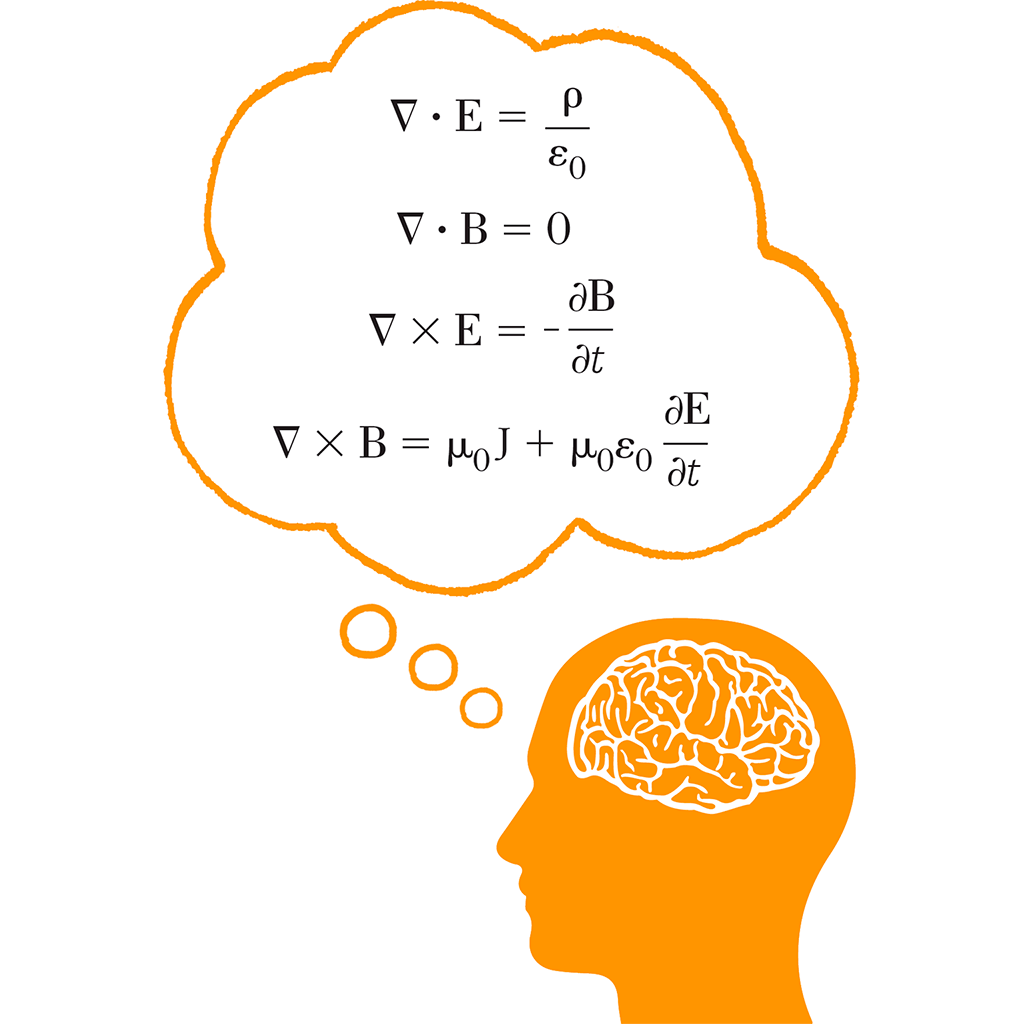
The Maxwell-Heaviside equations, although couched in the abstruse mathematical grammar of differential equations, actually provide a concise description of the structure and effect of electrical and magnetic fields.
JAMES CLERK MAXWELL

Born in Edinburgh, Scotland, in 1831, James Clerk Maxwell showed genius from an early age, publishing a scientific paper on geometry at the age of 14. Educated at the universities of Edinburgh and Cambridge, he became a professor at Marischal College in Aberdeen, Scotland, at the age of 25. It was there that he began his work on electromagnetism.
Maxwell was interested in many other scientific problems of the age: in 1859, he was the first to explain the structure of Saturn’s rings; between 1855 and 1872, he did important work on the theory of colour vision, and from 1859 to 1866 he developed a mathematical model for the distribution of particle velocities in a gas.
A shy man, Maxwell was also fond of writing poetry and remained devoutly religious all his life. He died of cancer at the age of 48.
Key works
1861 On Physical Lines of Force
1864 A Dynamical Theory of the Electromagnetic Field
1872 Theory of Heat
1873 Treatise on Electricity and Magnetism
See also: Alessandro Volta • Hans Christian Ørsted • Michael Faraday • Max Planck • Albert Einstein • Richard Feynman • Sheldon Glashow